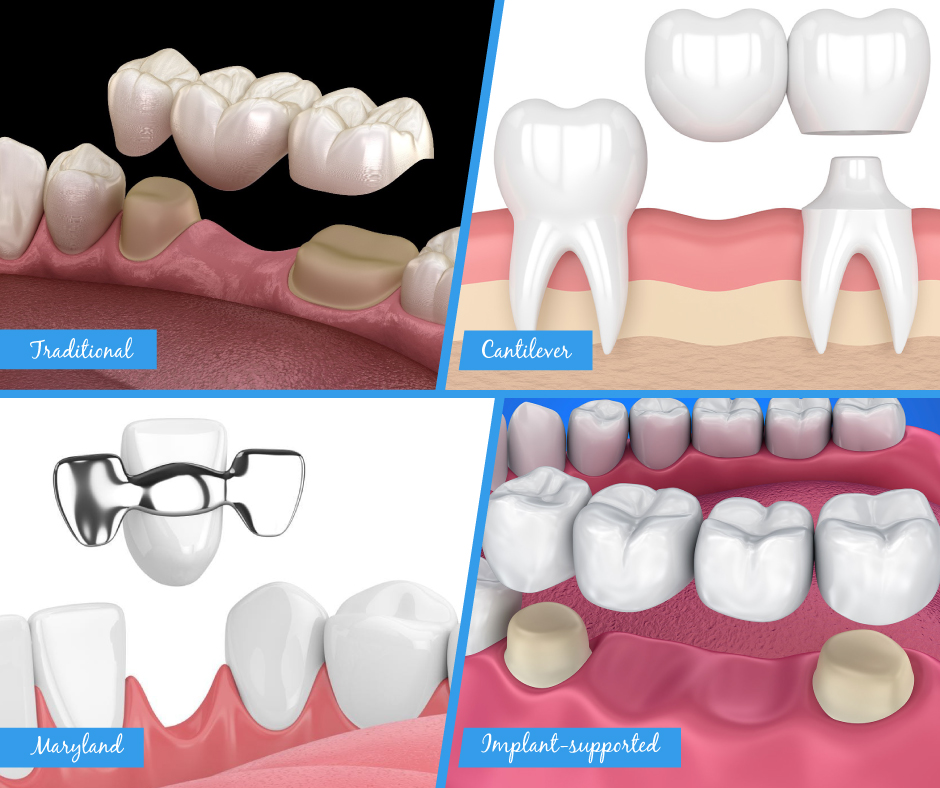Missing or losing a tooth is one of the most common dental concerns. Most of us have experienced this in our respective lifetimes despite practicing proper dental care and maintenance.
But, while it has become a usual thing for many of us, this kind of dental issue must be dealt with accordingly. Fortunately, science and technology have paved the way for experts to find the right solutions.
To date, dentists offer several options for patients to replace a missing tooth or teeth. One of these choices is a dental bridge.
Overview
Before the arrival of dental implants, dental bridges are what most experts would recommend to their patients with a missing tooth or teeth.
It is worth noting, however, that a bridge will only be appropriate if the conditions are met. So, not everyone may resort to this kind of treatment.
Nevertheless, they are false teeth or “pontics” to replace the missing ones. The neighboring teeth will act as the support to hold the fake tooth in place.
Pontics can either be from a gold material or porcelain. But, typically, they are made from the latter as it blends in with the natural aesthetics of the teeth.
Types of Dental Bridges
There are four types of dental bridges. These are the traditional, cantilever, Maryland, and implant-supported. Depending on the conditions of your dental and oral health, your dentists would recommend the best type that will fit your needs and wants.
- Traditional
A traditional dental bridge is the most popular type of all. It features a false tooth or teeth, which the cemented dental crowns hold in place to replace the missing tooth or teeth.
Patients who lost a tooth between two neighboring teeth, which are strong and firm, may resort to the traditional type. This is why people who lost a tooth on the outermost parts may receive recommendations from their dentists to utilize the other types of bridges.
- Cantilever
The cantilever type is ideal for people who lost a tooth with only one neighboring tooth. For instance, you lost your “wisdom” tooth, and you wish to replace it, this type is the best option for your case.
The structure and features are all the same as the traditional type of bridge. But, instead of two neighboring teeth, only one abutment tooth will need to hold the pontic in place and fill in the gap.
- Maryland
A Maryland dental bridge is more similar to a traditional one. The conditions require two neighboring teeth, on each side of the gap.
The only difference is that this type does not utilize dental crowns for the attachment. Instead, Maryland features a framework of either porcelain or metal, which dentists will attach at the backs of the neighboring teeth.
Also, this may cost a bit higher than the traditional type due to the formation of the framework. Nevertheless, the purpose is all the same, and that is to replace the missing tooth and fill the gap.
- Implant-Supported
Implant-supported bridges are the most advanced type of all. It features two processes as it uses a dental implant, instead of dental crowns and frameworks, alongside the bridge.
The treatment starts with an implant. Patients will need to undergo surgery to embed the dental implant in the jawbone.
The implants will go in each missing tooth to fill the gap. Once the surgery for this process heals, the treatment will proceed to the next step, wherein the dentists will place the bridge.
In the world of dental and oral health, this type of bridge is the most table. However, the treatment costs too high due to the meticulous surgeries. Also, it may take time before the whole treatment concludes because the implant will need to heal first before moving forward to the next step.
Benefits of Having Bridges
Having a dental bridge, whatever the type you choose, when you lose a tooth, will improve the quality of your lifestyle. Here are some of the apparent benefits that you may get after resorting to bridges:
- Ability to properly chew
A missing tooth or teeth causes difficulties when chewing food. Moreover, it increases the risk of having more dental and oral concerns when you let it stay that way. But, bridges may resolve these issues, even prevent them from happening as it restores the full and optimum condition of your dental and oral health.
- Improves the shape of the face
When you lose teeth or even a tooth, the gaps and spaces will force your face structure to adjust. It will affect your smile, and eventually, your confidence. But, considering that bridges replace a missing tooth or teeth, it would improve your facial structure, as well as your smile.
- Prevent teeth from moving out of place
The reason behind the reconstruction of the facial features, especially on the lower end of your face, is the fact that the spaces and gaps will force your teeth to move out of place. Having excessive space allows the teeth to adjust freely to take up the free space.
Final Thoughts
Dental bridges may cost you more than what a denture may require. But, keep in mind that bridges are more effective and efficient in resolving dental issues, centering on a lost or missing tooth.
If you are finding the right options for you, this guide may help. However, ensure to consult your dentists, as well, because they will know best the ideal treatments for your condition.











